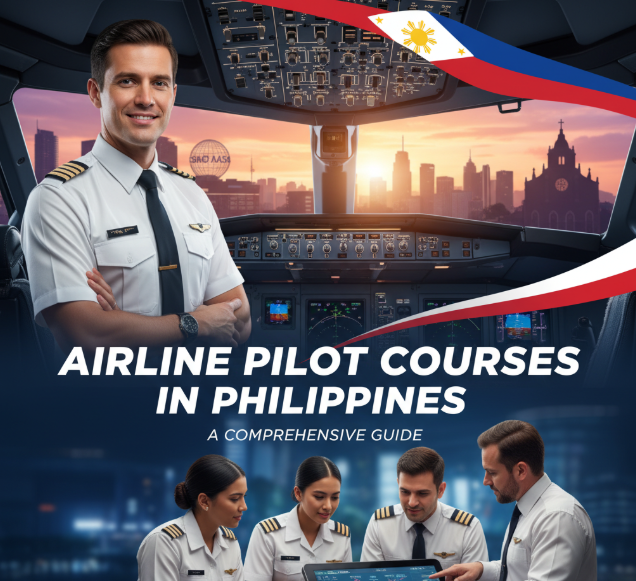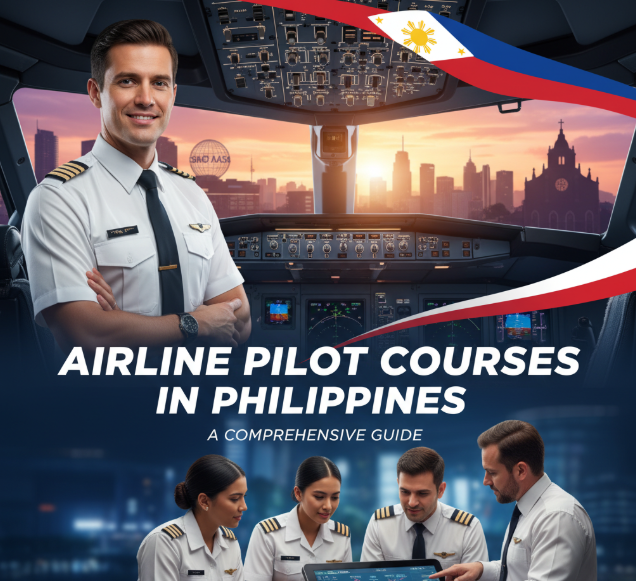
Introduction to Airline Pilot Courses in Philippines
A career as an airline pilot is one of the most prestigious and exciting paths for those passionate about aviation. For aspiring pilots, the Philippines offers a range of opportunities to embark on this thrilling journey. Airline pilot courses in the Philippines are designed to equip students with the skills, knowledge, and qualifications required to fly commercial and private aircraft safely and efficiently. This blog post will explore the various facets of pilot training in the Philippines, highlighting the importance of aviation, the types of courses available, and the future of this industry in the country.
Defining Airline Pilot Courses and Training Institutes
Airline pilot courses are specialized training programs designed to prepare students for a career as a professional pilot. These programs typically include classroom-based instruction, flight training, and practical experience in various aircraft types. The training focuses on key areas like aviation theory, navigation, meteorology, and flight procedures. The Philippines offers a variety of pilot programs at its numerous flight schools and aviation institutes, providing both local and international students with the necessary training to obtain a commercial pilot license (CPL) or even an airline transport pilot license (ATPL).
In addition to pilot training, aviation institutes in the Philippines often offer programs in aircraft maintenance, air traffic control, and aviation management, creating a holistic training environment for aspiring professionals. These institutes and flight schools serve as the backbone of the Philippine aviation industry, which continues to grow steadily.
Importance of Aviation in the Philippines
Aviation plays a critical role in the Philippines’ economy and global connectivity. The country is an archipelago of more than 7,000 islands, which means that air travel is essential for both domestic and international movement. With a growing number of international airlines and local carriers, the aviation sector is vital in driving the country’s tourism, business, and trade industries.
In recent years, the Philippine government has focused on modernizing airport infrastructure and expanding air routes to accommodate rising passenger traffic. The aviation industry is also crucial to the country’s role as a regional hub for flights within Southeast Asia. As a result, the demand for highly skilled pilots continues to rise, providing numerous career opportunities for those entering the field.
History and Development of Aviation in the Philippines
Early Aviation History of the Country
Aviation in the Philippines dates back to the early 20th century, with the first recorded flight taking place in 1910. However, the Philippines’ aviation industry began to take shape during World War II when the U.S. Air Force established bases in the country. After the war, commercial aviation rapidly expanded, and the national carrier, Philippine Airlines (PAL), was founded in 1941.
In the following decades, the Philippine aviation sector saw significant growth in both domestic and international routes. The establishment of other local airlines and improvements in aviation technology contributed to the Philippines becoming a prominent player in regional air travel.
Milestones in Aviation
- 1941: Philippine Airlines (PAL) was founded, becoming the first airline in the country and one of the oldest in Asia.
- 1960s: The Philippine government invested in expanding its airport infrastructure to cater to increasing domestic and international traffic.
- 1980s: The liberalization of the aviation sector allowed more private carriers to operate, further enhancing competition and services.
- 2000s to present: New airport terminals, expansion of international routes, and the emergence of low-cost carriers like Cebu Pacific and AirAsia Philippines have revolutionized air travel in the country.
Today, the Philippine aviation industry is poised for further expansion, especially with the government’s focus on improving aviation infrastructure and increasing connectivity to international markets.
Current Role of Airline Pilot Courses in Philippines
The role of airline pilot courses in the Philippines is indispensable to the country’s thriving aviation industry. These programs equip future pilots with the necessary certifications, flight hours, and theoretical knowledge to fly commercial airliners. Filipino pilots are in demand both locally and internationally due to their proficiency in flight operations, customer service, and English language skills, which are essential for global aviation communication.
The Philippines boasts several well-established aviation institutions that have earned a reputation for producing highly qualified pilots who work with both local and global airlines. Some of these institutions also collaborate with international flight schools and airlines, offering globally recognized training programs.
Eligibility, Training, and Skills Required
Basic Qualifications
To embark on a career as an airline pilot in the Philippines, candidates must meet certain basic qualifications, which typically include:
- Education: A high school diploma is the minimum requirement, though many aspiring pilots pursue a bachelor’s degree in aviation or a related field.
- Health: A medical examination is required to ensure that candidates are physically fit for the rigors of flying. This includes vision, hearing, and overall physical health assessments.
- Age: Most pilot training programs require candidates to be at least 17 years old. However, the minimum age for obtaining a commercial pilot license (CPL) is 18.
Technical and Soft Skills
In addition to meeting basic eligibility requirements, aspiring pilots must possess specific technical and soft skills, including:
- Navigation and Aerodynamics: Knowledge of flight planning, navigation systems, and understanding the science of flight.
- Meteorology: Understanding weather patterns and how they affect flight safety and route planning.
- Leadership and Decision-Making: The ability to make critical decisions under pressure, often involving the safety of passengers and crew.
- Communication: Clear communication skills in English, as it is the international language of aviation.
Institutes, Academies, and Training Centers in the Philippines
The Philippines is home to numerous flight schools and aviation institutes that offer airline pilot training. Some of the most well-known institutions include:
- Philippine Airlines Aviation School (PALAS)
A leading provider of pilot training in the Philippines, PALAS offers comprehensive programs for aspiring pilots, including both fixed-wing and rotary-wing training. - AeroCareers Flight School
A reputable flight school offering a range of courses, including private pilot licenses, commercial pilot licenses, and more advanced training. - Flight School Philippines
Known for its practical training and state-of-the-art simulators, this school provides professional pilot training, ensuring students are prepared for both local and international aviation careers. - University of the Philippines Aviation Institute
A prominent educational institution offering bachelor’s degree programs in aviation and aeronautics, along with pilot training programs. - Philippine State College of Aeronautics (PhilSCA)
A government-run institution that provides extensive aviation courses, including pilot training, aircraft maintenance, and air traffic control.
Government Initiatives
The Philippine government supports the aviation sector through various initiatives, such as improving airport infrastructure, promoting aviation safety, and encouraging international collaboration in aerospace research. National aviation authorities like the Civil Aviation Authority of the Philippines (CAAP) regulate pilot training and licensing standards, ensuring that the training programs meet international aviation standards.
Technology and Innovation in Aviation Training
The Philippines is also embracing modern technology to enhance the training experience for future pilots. Advanced flight simulators, virtual reality-based training systems, and digital cockpits are being used in many aviation schools to provide realistic flight experiences without leaving the ground. These technologies offer aspiring pilots the opportunity to practice handling emergency situations, navigation, and other complex flight operations in a controlled and safe environment.
Challenges Faced in Pilot Training in Philippines
While the Philippines has a robust aviation training system, there are several challenges that aspiring pilots must overcome:
- Cost: Pilot training is expensive, with costs ranging from $50,000 to $100,000, depending on the type of training program. This makes it difficult for some aspiring pilots to afford the full course.
- Regulatory Hurdles: Navigating the regulatory processes of obtaining a pilot’s license in the Philippines can be complicated and time-consuming.
- Infrastructure Gaps: Although there are improvements in infrastructure, some flight schools in remote areas still face challenges related to outdated training equipment or limited access to modern facilities.
- Brain Drain: Many Filipino-trained pilots seek better job opportunities abroad, leading to a shortage of local pilots for Philippine airlines.
Future of Airline Pilot Courses in Philippines
The future of airline pilot courses in the Philippines is bright, with significant advancements in technology, increased demand for pilots, and potential growth in space exploration. The emergence of private aviation and the possibility of space tourism also presents exciting opportunities for aspiring pilots. Innovations such as AI in cockpit training and automation in aviation are likely to shape the future of pilot training programs.
Additionally, international projects like NASA’s Artemis and India’s Gaganyaan are opening up new avenues for space-related training programs. Filipino pilots may soon find themselves involved in space-related missions, thanks to the global interest in space exploration.
Career Path & Opportunities
The journey to becoming a pilot in the Philippines involves several steps, each offering valuable experience and opportunities. The typical career path includes:
- Education: Obtain a degree in aviation or a related field.
- Pilot License: Complete flight training and obtain a private pilot license (PPL), followed by a commercial pilot license (CPL).
- Advanced Training: Gain additional experience through flight hours, and pursue advanced qualifications like the airline transport pilot license (ATPL).
- Career Opportunities: Work with airlines, charter companies, or in the growing space tourism sector.
Salary Expectations
A career as an airline pilot offers competitive salaries, with pay depending on the airline, experience, and type of aircraft flown. Local pilots earn well, and with international experience, they can command salaries upwards of $100,000 annually.
FAQs (10-12 Q&A)
- How much does pilot training cost in the Philippines?
Pilot training can cost between PHP 2,000,000 to PHP 4,000,000 for a commercial pilot license. - Which is the best aviation institute in the Philippines?
Some of the best include Philippine Airlines Aviation School, University of the Philippines Aviation Institute, and PhilSCA. - What qualifications are needed for pilot training in the Philippines?
Basic qualifications include a high school diploma, medical fitness, and being at least 17 years old. - Is international flight training available in the Philippines?
Yes, many flight schools in the Philippines offer international flight training programs recognized by global aviation bodies. - What is the future of aviation in the Philippines?
The future of aviation in the Philippines looks promising, with increased demand for pilots, expanding international routes, and growth in private aviation and space tourism.
Conclusion / Final Thoughts
Aviation is a promising career path in the Philippines, offering aspiring pilots numerous opportunities to work locally and internationally. With the right training, dedication, and perseverance, anyone can become a part of the exciting world of aviation. Aspiring pilots should explore the various training programs available in the Philippines and embark on a journey toward becoming a professional pilot.
